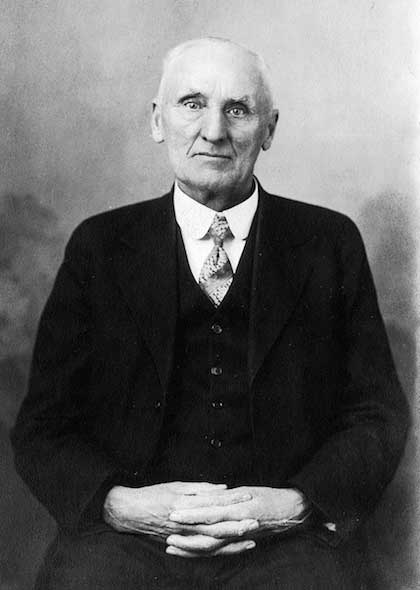Murray hamlet named for Edward Fancher, key leader in sandstone industry
“Overlooked Orleans,” Volume 2, Issue 47
Over a century ago, Orleans County was dominated by the Medina Sandstone industry which was directed by Edward Fancher of Albion for a number of years.

Edward Fancher
Born January 6, 1854 to John and Effie Bogardus Fancher, Edward engaged early on in the quarry business gathering much of his knowledge from Charles Gwynne. After the untimely death of his wife Lucy in 1892, Edward remarried to Ida Baldwin the following year and raised his young family in the Hulberton area.
On February 20, 1902 a new quarry syndicate was established in the area, uniting nearly 50 quarries sprawled throughout Orleans County. The Orleans County Quarry Company was incorporated with $2,000,000 in capital and employed over 1,200 men. Initial startup funds were directed towards operating the quarries, paying salaries, and most importantly, developing the infrastructure to support the refinement of stone, sale, and transportation across both railroad and the Erie Canal.
The newly established business situated its headquarters at Albion and immediately began the search for a general manager; meanwhile Fancher was sent to New York City to begin peddling the products of the burgeoning company. Within months of incorporation, the “syndicate” signed on to several major six-figure contracts for paving stones in New York City, which would aid in securing a promotion for Fancher to a position of superintendent of the company.
In the heat of this growing business, Fancher took an interest in studying theology and was ordained a minister on Sept. 27, 1912. Serving at numerous congregational churches in the region, he was responsible for restarting services at the “old pioneer” Christian church at Manning. It was a short time after that the quarry business hit a wall with the start of World War One, halting production and interest in the building material.
At the conclusion of the war, quarries were offered to individuals on a royalty basis with John Lubomski of Albion serving as the executive secretary. Once employees for the business, groups of men bought into the new system and took over management of individual quarries in the Albion and Murray area. Those such as Pasquale DiLaura, James and Edward Ryan, the Monacelli brothers, Camille and Henry D’Orazio, and Mario and William D’Andrea all entered into agreements with the company to manage the very quarries they once toiled in.
The advent of the Great Depression marked an end to the golden age of the sandstone business in Orleans County as most quarries sold the stock they had and ceased the removal and cutting of stone from the quarries. At the conclusion of World War Two, new industries created a void in skilled labor for quarry work and new construction materials replaced the once valuable stone.
The lasting impact of Fancher’s contribution to the region is still recognized today, when passing through the hamlet of Fancher, driving down Fancher Road, or hitting the “Fancher Curve,” these remain a testament to the ingenuity and hard work of the Rev. Edward F. Fancher who headed the growth of the Medina Sandstone industry at the turn of the 20th century. His passing on March 19, 1942 was marked by great sadness across the county, many recalling his dedication and contributions to the community.








































































